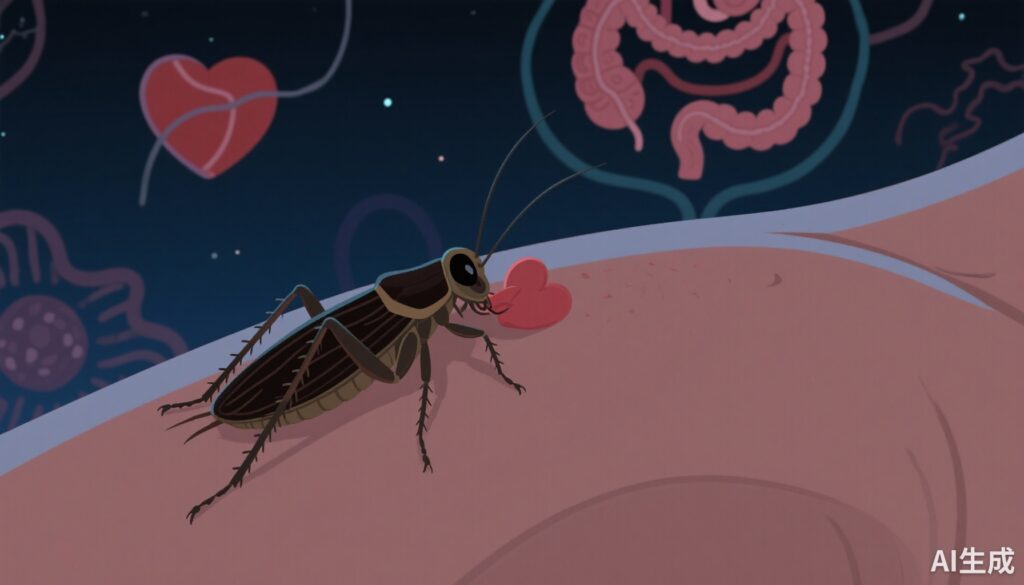Introduction: An Emerging Public Health Concern
In recent years, the U.S. Centers for Disease Control and Prevention (CDC) issued a warning that “kissing bug”-transmitted Chagas disease is silently spreading across parts of the United States. Previously considered a tropical disease endemic to 21 countries in the Americas, Chagas disease is now detected in 32 U.S. states where these insects—the triatomine bugs—are found. Once overlooked, experts are increasingly recognizing Chagas disease as an emerging public health threat in the U.S., urging heightened awareness and preventive efforts.
The Mysterious ‘Kissing Bug’ and the Origins of Chagas Disease
Chagas disease, also known scientifically as American trypanosomiasis, is caused by the parasite Trypanosoma cruzi. The primary vector for its transmission is a family of insects called triatomine bugs (Triatominae), colloquially known as “kissing bugs.” These bugs are small, about 2.5 centimeters in length, with flat bodies resembling lice and mouthparts adapted for piercing and sucking blood—similar to mosquitoes.
Their peculiar nickname comes from their predilection for biting humans on exposed skin, especially at the border of mucous membranes like the corners of the mouth, usually while people are asleep. Most species of triatomine bugs bite painlessly and may go unnoticed, although some blood-feeding species can cause painful reactions, including swelling, hardened skin nodules, or even hives.
What makes the kissing bug particularly dangerous is not just its bite but what it leaves behind. When feeding, the bug defecates on the skin, and its feces may contain infectious T. cruzi parasites. If a person inadvertently rubs this contaminated fecal material into broken skin, an eye, or the mouth, the parasite gains entry into the body and initiates infection.
Understanding Chagas Disease: A Stealthy Invader
After infection, Chagas disease often starts quietly. Many individuals experience no symptoms or only mild signs resembling a viral illness: fever, headaches, muscle pain, or rashes. Because these symptoms are nonspecific and transient, infection frequently goes unrecognized.
The real danger lies in the disease’s chronic phase. Over years to decades, T. cruzi parasites slowly damage critical organs, primarily the heart and digestive system. This insidious progression can lead to severe heart complications such as arrhythmias, cardiomegaly (enlarged heart), and eventually heart failure, which can be fatal. Similarly, the digestive tract may suffer from impaired muscle function causing problems like difficulty swallowing, constipation, and abdominal discomfort, significantly lowering quality of life.
Chagas Disease in the United States: Changing Epidemiology
Historically, Chagas disease was not considered endemic to the U.S., with most cases reported as imported infections in travelers or immigrants from Latin America. However, recent entomological surveys confirm the presence of triatomine bugs in 32 states.
CDC investigations increasingly identify locally acquired infections, prompting experts to propose classifying Chagas disease as an endemic illness in parts of the U.S., especially in the southern states. Environmental changes, climate warming, and expanding habitats of triatomine bugs contribute to the risk increase.
Who Is at Risk? Identifying Vulnerable Populations
Individuals living in substandard housing or rural areas—where triatomine bugs can nest in walls, cracks, or thatched roofs—face the highest infection risk. In Latin America, impoverished communities are more affected due to their dwelling conditions. Similar socioeconomic and environmental risk factors are relevant in the U.S. context.
Those traveling to endemic regions in the Americas should also be aware of the risk and take precautionary measures. Blood transfusion and organ transplantation have been recognized routes of transmission, highlighting the importance of screening donors in affected areas.
Preventing Chagas Disease: Practical Measures
Preventing transmission centers around avoiding insect bites and reducing vector habitats. Key recommendations include:
– Inspecting and sealing cracks or openings in houses that may harbor bugs.
– Using insecticides appropriately when authorized.
– Sleeping under insecticide-treated bed nets or mosquito nets.
– Wearing protective clothing such as long sleeves and pants when in endemic areas.
– Avoiding the rubbing of eyes or face with contaminated hands.
Travelers should be informed about the risks and take relevant precautions, including choosing accommodations with screened windows and air conditioning where possible.
Misconceptions and Common Concerns
A prevalent misconception is that the “kissing bug” name implies some harmless or even affectionate interaction, which belies the serious health risks posed by its bite. Another misunderstanding is that the disease is only a tropical problem; however, changing ecological conditions are expanding its geographic reach.
Moreover, many people believe that Chagas disease always presents immediate symptoms, but its often silent course leads to underdiagnosis. Increased awareness among healthcare providers is essential to identify and treat cases early.
Medical Management and Current Challenges
Diagnosing Chagas disease relies on blood tests detecting the parasite or antibodies, with early detection being critical. Antiparasitic treatments such as benznidazole or nifurtimox are effective mainly in the acute and early chronic phases but have limited benefits once significant organ damage occurs.
There is no vaccine, so prevention remains paramount. Public health surveillance and education programs are vital to limit disease spread and identify infected individuals for treatment and monitoring.
Expert Insights on Controlling the U.S. Outbreak
Dr. Lisa Monroe, an infectious disease specialist at CDC, comments, “Chagas disease in the U.S. represents a silent emerging threat. We need concerted efforts integrating vector control, screening, research, and education to prevent its further spread.”
Many experts emphasize the importance of community engagement and improving housing to reduce triatomine habitats as long-term sustainable strategies.
Patient Scenario: Mark’s Unexpected Diagnosis
Mark, a 45-year-old man living in rural Texas, recently experienced unexplained fatigue, mild chest discomfort, and worsening swallowing difficulties. Unaware of any insect bites, he initially attributed symptoms to stress and aging. Eventually, his physician considered Chagas disease after learning about kissing bugs in his area.
Blood tests confirmed T. cruzi infection. Early intervention with antiparasitic drugs helped control the infection, but Mark will require ongoing cardiac and digestive evaluations to manage chronic complications. Mark’s case illustrates that anyone in regions with kissing bugs may be at risk and underscores the need for awareness among patients and clinicians alike.
Conclusion: Vigilance Is Vital Against a Neglected Threat
Chagas disease, once a distant tropical disease, is becoming an important health concern in the United States due to the spread of its vector, the kissing bug. Its subtle onset, serious long-term health consequences, and under-recognition pose substantial challenges.
A multipronged approach involving public education, housing improvements, vector control, and clinical awareness is essential to curb the disease’s impact. By understanding its transmission, symptoms, and prevention strategies, individuals and healthcare professionals can work together to protect public health against this silent but deadly invader.
References
1. Centers for Disease Control and Prevention. Chagas Disease. https://www.cdc.gov/parasites/chagas/index.html
2. World Health Organization. Chagas disease (American trypanosomiasis). https://www.who.int/news-room/fact-sheets/detail/chagas-disease-(american-trypanosomiasis)
3. Bern C, Montgomery SP. An estimate of the burden of Chagas disease in the United States. Clin Infect Dis. 2009;49(5):e52-4.
4. Garcia MN, Woc-Colburn L, Aguilar D, et al. American Trypanosomiasis (Chagas Disease) in the United States: A Public Health Approach. Clin Microbiol Rev. 2015;28(1):80-93.
5. Hotez PJ, Bottazzi ME. Neglected tropical diseases of the United States and their global partners. PLoS Negl Trop Dis. 2010;4(6):e627.



